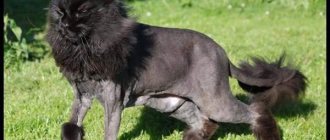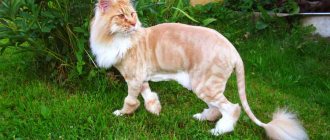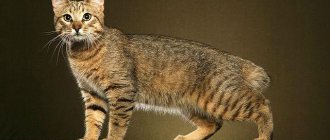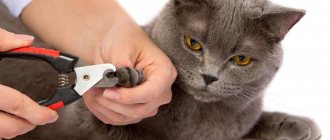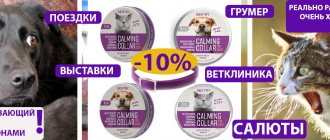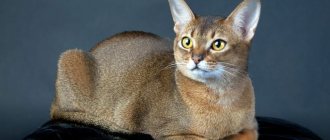History of the Scottish Straight cat breed
Scottish Straight cat Scottish Straight are the same Scottish folds, but with a modified position of the ear.
Straight ears do not have a characteristic crease and are set straight, and this, in fact, is the only external sign that distinguishes them from their fold-eared counterparts. Scottish cats are considered one of the youngest cat breeds. The first cat with an unusual, flattened ear shape appeared on a Scottish farm in the early 60s. Surprisingly, the ancestor of modern folds and straights had no pedigree and simply chased mice through the barns of local peasants. The first official Scottish breeder was an ordinary villager, William Ross, who adopted a kitten from the aforementioned Fold. A few years later, professional breeders also joined the process. At the same time, experts witnessed an interesting phenomenon: in the litters brought by even the most purebred Scottish dogs, babies with erect ears appeared. Of course, no one intended to separate such individuals into a separate breed. And kilometer-long queues did not line up for straight-eared kittens, because against the backdrop of touching folds, they were outright losing. But here nature itself intervened.
Very soon, Scottish breeders noticed that attempts to strengthen and strengthen the lop ears of animals had a negative impact on their health. The mutated gene responsible for the flatness of the ear folds began to inhibit the function of the skeletal apparatus of cats. As a result, the Scots began to suffer from thickening of the bones and osteochondrodysplasia. To keep the breed afloat, breeders rushed to look for “new blood” that would help the Scottish survive and reduce the number of their genetic defects. Through trial, error and outcrossing, it was discovered that the healthiest and most beautiful offspring can be obtained from crossing a Fold cat and a straight-eared male of the same breed. It was thanks to this discovery that breeders and felinological associations finally turned their attention to straight-eared Scots. Well, in 2004, the Scottish Straight subspecies received official recognition from the World Cat Federation and the status of an independent breed, which sharply increased the attractiveness of straight-eared cats in the eyes of potential buyers.
Appearance of the Scottish Straight
Scottish Straights can easily be confused with the British, although representatives of these two breeds have a minimum of common genes. Scottish Straight cats are much smaller than their competitors from Albion, although they have a longer body. The weight of an average straight is 3-3.5 kg. Modern breeders are still wondering what kind of offspring they will get after mating a fold and a straight, since initially all kittens are born with ordinary ears, which change their position only at the end of the first month of life.
Head
Whiskered Scottish
According to the WCF standard, Scottish Straights must have a rounded skull. Representatives of this breed have convex foreheads and cheeks. In cats, the area of the cheekbones and cheeks is noticeably more rounded than in cats. The chin of the Scots is firm, rounded, but does not protrude forward. The whisker pads are distinguished by their characteristic “swelling” and have the shape of a regular oval.
Nose
Wide and short, with a slight arch of the back and a pronounced base, practically without a stop.
Eyes
Large and round, widely spaced. The gaze is open, inquisitively focused. Eye color depends on the coat color of the animal.
Ears
Erect, small, with a wide base. The tips of the ears are rounded and point forward. The outer part of the ear is covered with thick, close-fitting hair. The inner part is decorated with lush and stiff hair brushes extending beyond the edge of the ear.
Neck
The Scottish Straight cat has a muscular and short neck.
Scottish Straight muzzle
Frame
Moderately long, muscular and wide, tending to the rectangular type. The silhouette line is soft and rounded.
Limbs
Proportional to the body, that is, moderately long and strong, with developed muscles. The paws are oval, the toes are tightly clenched.
Tail
Medium or long, mobile, reaching to the middle of the shoulder blades.
Wool
Scottish Straight tabby color
Short or semi-long (in Highland individuals). Double, plush type, with well-developed undercoat. It does not adhere to the body, but covers it tightly. The texture of the coat may vary slightly depending on the season, as well as the type of color of the animal.
Color
The standard allows all types of colors found among representatives of this breed. The most typical color options for Scottish Straight cats are solid, bicolor, point, tabby, particolor, chinchilla, ticked, van and shedded.
Defects in appearance and disqualifying defects
Individuals with semi-erect or too wide ears with a British set are considered not the most successful representatives of their breed. The flat forehead, pronounced stop, long legs and small eyes of the Scottish Straight are also not decorative. Animals with an insufficiently long, inactive and kinked tail, cryptorchidism and everted toes are subject to unconditional disqualification. Weak and sick cats are also not allowed to participate in exhibition events.
Kittens from a Scottish Fold cat, with an average of five straight-eared and one fold-eared
How often can you groom an animal?
The regularity of haircuts depends on 2 factors: the cat’s reaction and possible consequences for its health. If the first haircut provoked long-term stress or lowered the status of the animal among other four-legged animals, then in the future it is worth abandoning such procedures.
You also need to pay attention to how the haircut affected the structure and color of the coat.
Before grooming your pet, it is advisable to seek advice from a professional groomer or veterinarian.
Important! Shorthaired Scottish Fold Fold cats are groomed no more than once a year. Longhaired Highlands will take even longer to fully recover from the first treatment.
What should you know about grooming?
Grooming cats is a complex process with many nuances.
- Under no circumstances should you cut your head, ears or whiskers: there is a risk of damaging the whiskers.
- Don't cut your tail bald: most cats try to chew it and cause serious wounds to themselves. Keep hair on at least one third of the tail.
- The same applies to the paws: it is imperative to leave “toes” in the area of the toes and the lower joint of the paw. But their length may vary.
- After shortening, the color of the coat may change dramatically.
- It is better not to cut animals with color point or tipping color at all: after this, the coat will sharply darken.
- The ideal length of shortened wool is 3 mm. It feels like velor fabric or plush to the touch, does not prick and does not cause discomfort to the animal. If you cut with a 1 mm nozzle, then the first week the hairs will be very stiff and only then will they acquire their usual softness.
- Don't cut your cat's hair. The skin of these animals is very delicate and can easily burn even in not too hot sun. In addition, the fur reliably protects them during play, and a hairless cat can seriously be scratched simply by scratching.
- Tangles can only be removed using a machine. Scissors should be used only as a last resort and with extreme caution. To do this, a fine comb is threaded under the mat, and the wool is carefully cut over it.
- If you are preparing for an exhibition, take care to do your pet's hair no later than six months in advance. Then it can be corrected a little.
Is it necessary to trim during shedding?
Long-haired and even short-haired animals are also cut during molting, because... this helps to get rid of some of the hair, because when it is short, dead hairs fall out more easily, and besides, they are not so long, and therefore do not fly around the house. However, there are other more effective ways to deal with shedding: shaving and trimming are not a priority.
Article continues after advertisement
You cannot cut cats of shaded and point colors, because... The new coat will grow darker. And remember: some cats, after a haircut, do not grow hair to the previous length or grow it very slowly. In addition, the coat may become thinner after cutting.
Scottish Straight character
It would be a big mistake to label all Scottish Straights as phlegmatic philosophers. Moreover, among these imposing cats, sometimes there are real livelies who love to chase a wind-up mouse and measure their strength with the owner. And yet, for the most part, Scottish straight cats do not have a violent temperament. Proud and serious, they cannot stand total control and are unlikely to allow themselves to be squeezed into a semi-conscious state. This, of course, does not make Scottish ascetics and sad hermits, they just require a little more independence and personal space than representatives of other breeds. Straights prefer to spend their free time in peace and quiet, lounging on the couch and learning Zen in the Buddha pose.
Squeezing the cat
The Scots are happy to make contact and join in the games, but only when they want to. In all other cases, it is better to leave the cat alone. The peak of motor activity of straight-eared Scottish cats occurs in the first year of their life. By the way, Scottish babies in their playfulness and restlessness are practically no different from ordinary outbred kittens. Adults, on the contrary, are famous for their exemplary behavior and patience. If you go on a visit for a couple of hours, leaving the Straight alone, he will easily survive it. However, weeks of loneliness, interrupted by rare raids from the owner, will not improve the character of the animal. As for the pacifying purr of straight-eared Scottish cats, it still needs to be earned: cats purr infrequently, and meow only in exceptional, from their own point of view, cases. Scottish Straights accept strangers and noisy groups of guests in a completely “secular” way, which means without unnecessary suspicion and aggression, but also without wild delight.
Scottish Straight cats are emotionally stable and not subject to sudden mood swings. However, exceptions to the general rule have not been canceled, so amateur videos with catchy headlines like: “The most disgruntled Scottish in the world” periodically appear on the Internet. In addition, straights are characterized by amazing persistence. If a cat wants something, he will definitely achieve it, following on the heels of the owner, and sometimes reinforcing his actions with annoying meows.
Training and education
Scottish Straight
Intelligent by nature, Scottish Straight cats are easy to educate and very difficult to fully train. Teaching a Straight to use a litter box and a scratching post is not at all difficult, provided that this process was started in time, before your pet matures. By the way, young Scottish cats are active and sometimes uncontrollable, so in the first months of the baby’s life you will have to put up with the inevitable destruction in the house.
Even if the fame of Yuri Kuklachev haunts you, it’s better not to get carried away with the serious drill of straights. Whatever the experts say, unquestioning obedience to commands is not the strong point of Scottish straight-eared cats. Instill in your pet the basics of etiquette and teach him to respect subordination - this will be quite enough. As for a full-fledged training program, save it for show-class individuals, who will later have to demonstrate their talents at exhibitions.
- If the animal allows itself too much, try to stop it with the command “No!”, which is given in a stern and loud voice.
- If the kitten does not respond to a stern tone, grab it by the scruff of the neck and imitate a cat hissing. The baby will understand this language faster.
- Do not try to poke the kitten's muzzle into the puddle it has made or try to hammer the basics of cleanliness into it with a slipper. After suffering stress, the cat will definitely play a mischief in another place, but this time it will be reliably hidden from you.
- Have you noticed that your plush beast is sitting in an unambiguous position on the carpet or trying to steal food from the table? Scare him with a loud whistle or clap of your hands. Make no mistake, fear is a very powerful educational tool.
- Never scold or praise a Scottish Straight cat after the fact. Despite a fairly high level of intelligence, the animal is not able to connect together yesterday's exemplary behavior and today's reward.
Why do you need to groom your pets?
There are many situations in which grooming cats is acceptable, if not vital. And we’re not just talking about going to a felinological competition. Very often, veterinarians advise resorting to grooming when they notice a problem with the animal’s fur or skin.
In this regard, all types of haircuts for cats can be divided into two categories:
- Model.
- Hygienic.
Model grooming is performed mainly for exhibitions and is a real work of art.
A completely different matter is cutting the fur, which is necessary to maintain the health of the pet. Hygienic cat grooming has a more familiar look and is easy to perform:
- Most often, it is done to avoid matting of long hair or to remove formed tangles that cause pain to the cat.
- Cats actively lick themselves and can either injure themselves trying to gnaw out the mat, or eat a lot of hair, which rolls into lumps in the stomach and can cause intestinal obstruction.
- The veterinarian may prescribe a haircut in case of skin diseases or parasites.
- Some animals have a problem such as feces sticking to the long hair near the hind legs and tail. In this case, you don’t have to cut the whole animal, but just shorten the “pants” a little.
- Many cats with long or semi-long hair undergo grooming in the summer heat to protect them from overheating. This is especially necessary for Siberian cats, Persian cats, Norwegian forest cats and others accustomed to colder climates.
- It also happens that an old or sick animal cannot care for its fur on its own. In this case, a haircut helps him stay clean and look decent.
Model haircut "Dragon"
Model cat grooming can be done not only for a trip to an exhibition. Many owners regularly visit the salon to give their pet an original look. Each hairstyle is individual. And yet, there are several of the most popular varieties, on the basis of which groomers create their exclusive works of hairdressing art.
- "French Lion" For this hairstyle, the back, top of the paws and base of the tail are completely trimmed. The head and neck fur remain intact, giving the impression of a luxurious mane. The tip of the tail is not cut either. A specialist can give it the shape of a lion tassel, a pompom, a stepped herringbone or a neat whisk. Sometimes the fur is shortened just a little, resulting in a fluffy squirrel tail. The length of the “socks” and “gloves” on the paws can also vary. Thus, a unique image of the animal is created.
- "Puma." This haircut is done in almost the same way as the “Lion” option, but in addition the fluffy shirtfront on the chest is preserved.
- For the “Dragon” model, the sides and belly are cut smooth, while the hair along the ridge and tail remains untouched. It is only given the shape of a carved comb with sharp teeth.
- “Puss in Boots” fully corresponds to its name: the fur on the animal’s back is shortened, and the upper part of its paws is cut off to make neat boots.
There are also more intricate haircuts - such as “Modern”, “Continental”, “Harlequin”. All of them are performed only by specialists.
Model haircut "Puss in Boots"
The question of whether to contact a specialized office or trim the pet’s fur themselves arises among owners very often. There are quite a lot of arguments in favor of both options. Grooming cats at home is much cheaper, and many mustachioed purrs perceive trips to the salon as very stressful.
The difficulty is that not all animals tolerate grooming calmly. Some people so actively resist attempts to cut their hair that they have to be sedated. Most often, mild muscle relaxants are used in this capacity: these medications do not completely immobilize the cat, but reduce activity and make all its reactions more inhibited. Only a professional can choose the right medicine, give the correct injection and monitor the condition of the four-legged patient.
Even choosing a shampoo for bathing before a haircut sometimes turns into a difficult task. An incorrectly selected grooming product can damage the coat, cause allergies or skin irritation, and in the worst case scenario, even cause the animal to go bald.
Additionally, cat grooming varies greatly in difficulty. Hygienic or the simplest of model haircuts, such as “lion”, “puma” or “puss in boots”, can be easily done at home. Others, more complex ones, can only be done by a specialist. Thus, it is often much easier to pay for a trip to a clinic or salon. Usually a groomer gives a cat a haircut in an equipped office, however, a home call is quite possible.
Animal clipper
If you still decide not to go to the salon, then keep in mind: grooming cats is not the easiest task. You will need a lot of patience and some tools:
- Hair clipper.
- The attachments for it are at least 3 mm long (it is best to use veterinary attachments No. 3 for these purposes).
- Comb-comb.
- Regular or hairdressing scissors (if you want a “designer” hairstyle, you can take both regular and filer scissors).
- A high table or ironing board at which you can work comfortably.
- Just in case, prepare hydrogen peroxide and cotton wool.
And, of course, you need to take into account that for such a procedure you will need an assistant, or better yet two. After all, most animals perceive attempts to cut their hair very aggressively, and someone will have to hold the wayward cat so that she does not injure her “hairdresser.”
Place your pet on the tabletop, holding him by the front and back legs so that he cannot twitch. Carefully trim the fur first on the back, then on the belly, paws and tail. If necessary, trim any stray hairs.
After completing the procedure, be sure to bathe the animal to wash off any remaining hair on its skin.
Professional groomer kit
If you have dreamed of getting yourself a lion since childhood, but there was no opportunity, then this video will show you how to transform...
How to cut your hair at home
Tools and accessories
You can only trim a very calm cat at home, and if it is already accustomed to such a procedure. The easiest option is to trim the fur with a machine with one attachment. Every owner should have the simplest skills necessary for grooming a pet. In hot weather, a short hairstyle can save your long-haired pet from heatstroke.
You will find most of the cutting equipment at home. The procedure can be done on a table, covered with a sheet, or on an ironing board. In the latter case, the “stand” must be stable. Scissors - simple and thinning - will also come in handy. Hair clippers are also often found in homes. If not, you can purchase it at the store. It should be comfortable and have various attachments. You cannot do without it when performing the procedure. Also purchase three percent hydrogen peroxide and cotton wool. Your pet should also have a comb-comb.
A minimum of two people will be needed to perform the procedure. It is better if the helpers know how to handle cats.
Care and maintenance
Scottish Straights are typical domestic cats for whom walks in the fresh air are pleasant entertainment, but not more than that. This is why Scots are considered ideal pets for homebodies. In everyday life, straights are unpretentious and rarely cause trouble. Take your animal for routine veterinary examinations, carry out timely vaccinations, use high-quality food - and straight-eared Scottish cats will not create any problems for you.
Hygiene
Scottish Straight loves its owner
Scottish Straight cats are very clean cats that carefully monitor the condition of their own fur, but they still need to be bathed from time to time. Usually, cats are washed as their “coat” gets dirty, using shampoo from the pharmacy. At the end of the procedure, you can apply a balm to the coat. When bathing, make sure that water does not get into the animal’s ears and be sure to protect the wet pet from drafts.
Owners of show-class specimens preparing to participate in exhibitions will have to work a little harder. In particular, a few months before the event, the cat begins to be washed daily to completely remove dead cells from its skin and stimulate the growth of new fur. In addition, you will have to spend money on a variety of professional coat care products, ranging from degreasing paste to texturizing conditioner. Brush Scottish cats once a week with a short hair brush. Claws are trimmed as they grow. Be sure to monitor the condition of your cat's eyes and remove unwanted discharge with a swab soaked in hygiene lotion.
Feeding
The diet of Scottish Straights is no different from the “menu” of their fold-eared counterparts. Just like folds, Scottish straight-eared cats benefit from lean meat, offal, boiled sea fish, fermented milk products, and egg yolk. In addition, the animal’s diet should include vegetables (raw or stewed), cereals and sprouted wheat.
Prohibited
- Fat meat.
- Beans and potatoes.
- Bones.
- Sweets, spices, smoked foods.
- Garlic and onion.
- Bread.
- River fish.
- Citrus.
- Mushrooms.
- Raw eggs.
Curious Scottish Straight
In serious nurseries, Scottish Straight kittens are sold starting from the age of three months. During this period of life, the baby no longer feeds on mother's milk, which means it is able to eat the same food as an adult animal.
An important point: natural-fed straight cats do not receive enough of the vital microelements. Vitamin and mineral complexes, which can be purchased at a veterinary pharmacy, solve this problem.
Scottish Fold cats can also be fed commercial food if you are willing to spend money on its non-budget varieties - “premium”, “super premium” and “holistic”. An ideal cut for a Scottish dog should contain at least 26% protein and about 9% fat. It is advisable that the food does not contain wheat and corn, which can cause allergies in the cat. From this point of view, the most useful options for “drying” can be considered the Canadian Acana Pacifica Cat and the American Earthborn Holistic.
Three-month-old Scots are fed up to 6 times a day, six-month-old kittens eat 5 times a day, nine-month-old kittens - 4 times. One-year-old individuals are considered adults, so 2-3 meals are enough for them.
Technique of the procedure
Before grooming Scottish Folds, it is recommended to trim their nails. You can also use thick wristbands to protect your wrists from scratches.
The procedure is carried out in several stages:
- Apply a degreasing composition to dry wool and rub it well along the entire length of the hair. In longhaired Scots, special attention is paid to the tail, hind legs and collar area. To the rest of the body (including the head), the drug is usually applied without much effort.
- After the period of time specified by the manufacturer, the product is washed off with water.
- Apply the main shampoo, rub it with your hand until foam forms and after 2-3 minutes rinse thoroughly. The procedure can be repeated several times (depending on the degree of contamination of the wool).
- The final stage is treatment with conditioner, which gives the wool shine, silkiness and covers it with a protective layer.
- After bathing, the Scottish cat is wrapped in a towel and the coat is dried.
- The haircut is performed using a special electric clipper, but in the groin area and under the tail, the hair is carefully removed with ordinary scissors.
- Scissors are also used to form curly elements of the hairstyle and trim.
After grooming, the Scottish cat needs to be washed again with shampoo. This will remove cut hairs and wash out the bottom layer of fur that may not have been completely cleaned during the first bath.
Grooming a cat is a rather labor-intensive and complex process, since most pets do not tolerate such procedures well. Therefore, unless absolutely necessary, you should not subject the animal to such a test. And if the owner is not confident in his skills, then it is better to seek help from professionals.
Model fur processing
To create a beautiful hairstyle, a model haircut is used. It is produced using hairdressing and thinning scissors and various combs. Nozzle No. 3 is usually put on the machine.
It is necessary to consider some interesting cat hairstyles that are currently the most popular. Grooming cats requires a great deal of imagination and artistic taste. They can create such a creative image as a lion or a dragon.
For example, how to cut a cat like a lion: the hair is left at the tip of the tail and around the head, creating a lion's mane.
Such model cat haircuts serve both hygiene and image.
Dragon hairstyle:
- The fur remains only on the head, paws and tail.
- A strip is left along the top of the entire length of the back, along which triangles are then cut, reminiscent of the appearance of dragon teeth.
- The tail is decorated with the same triangles. Thus, the cat becomes like a little dragon.
Sometimes different designs are created on the back or sides in the form of letters, circles, triangles, squares, etc. You can do all this yourself, in a beauty salon, or call a specialist to your home.
Before the event, you need to stock up on hydrogen peroxide or iodine. An assistant holds the paws. Start from the back, then moving to the sides. The paws can be trimmed with scissors. Work very carefully on the abdomen and intimate area. If your cat behaves strangely for a few days after the haircut, you should contact your veterinarian.
How shelters for cats and dogs work in Moscow
Grooming
Once or twice a week you need to comb the British coat with a medium-frequency metal comb and a massage brush with natural bristles. First with the growth of the fur, and then against the grain. You should start from the pet's back, then scratch along the sides, moving to the chest. The cheeks and neck are combed towards the cat's face. After the combing procedure, all excess hair is removed using a rubber mitten or wet palms.
Is it necessary to cut a British cat's haircut?
For your information! It is recommended to finish this procedure by applying a protein conditioner or anti-shedding spray to the combed coat. Such products can improve the structure of the coat and maintain a healthy shine.
About once every three weeks, it is recommended to clean the coat with dry shampoo or powder, which is massaged into the coat and then thoroughly combed out with a brush. Such products contain silicone and special components that cleanse the coat of subcutaneous fat and dirt, remove static electricity and add volume.
Once every three months it is necessary to bathe the cat using high-quality shampoo, which contains lecithin, conditioner and antistatic components. After washing, dry the coat thoroughly using several towels and, if the cat is not afraid, a hair dryer, and then comb thoroughly.
Combing out the excess hair of the “British” should be done 2 times a week.
Combing allows you to get rid of excess falling hairs, which, during the licking process, end up in the “British”’s gastrointestinal tract. A hairball can lead to a blockage in the stomach and intestinal obstruction, causing the cat to suffer from lack of appetite, constipation and vomiting. Trying to avoid such problems, owners are thinking about grooming British cats.
Health and disease of the Scottish Straight cat
Scots live up to 15-20 years of age without much difficulty, but only if they were properly cared for and mandatory veterinary procedures were not neglected. Unlike folds, straights have practically no genetic mutations or hereditary diseases, so representatives of this breed are relatively healthy animals with good immunity. As for diseases of the gastrointestinal tract and genitourinary system, sometimes diagnosed in straight-eared Scottish cats, they are most often caused by poor nutrition.
The dangers of haircuts
A trimmed Maine Coon loses important qualities:
- Heat exchange and touch are disrupted.
- The structure of the coat changes - it becomes fluffy and soft, similar to the wool of a Persian.
- The psyche is disturbed, the animal experiences stress and may hide.
- The guard hair does not grow back for a long time.
Everyone knows that a cat's whiskers play an important sense of touch and will never be trimmed. But few people know that there are tactile points on wool too. Without them, the cat begins to perceive what is happening around differently, its behavior changes. A Maine Coon feels really stressed after a haircut.
Shaving, especially with a clipper, slows down hair growth. Plus, it changes its structure, becomes thin, fluffy and can begin to curl. In veterinary medicine there is a term “follicular arrest” - this is when, after cutting, the follicles go into hibernation and take a very long time to recover. In Maine Coons, as they have a thick undercoat, this type of alopecia is also possible. And if in young animals the coat is restored within 3-4 months, then in older coons the process is long.
Why groom cats?
Typically, cats are clipped for two reasons. The first is to take care of the pet’s health, and the second is to add attractiveness. Regarding health status, there are medical indications for grooming:
- skin diseases;
- infestation with ticks and fleas;
- hyperplasia.
In all these cases, the skin should be treated with medications and haircuts cannot be avoided. Also, with age, it is difficult for elderly pets to keep their fur coat in good condition, so by trimming the fur, the owner makes it easier for himself to care for his pet.
There are also cases when an animal was picked up on the street, and the cat looks unsightly: tangled fur, pellets and “icicles.” The only way to help your pet and bring it back to normal is to trim its fur. But it will be difficult to manage on your own.
Scissors should not be allowed in as they can damage the skin. It is also unlikely that you will be able to comb matted fur. Bathing is problematic, since tangles take a long time to dry and can lead to inflammation. The only way out is to shave your pet and continue to provide careful care. You should shave with a clipper carefully, holding the skin so as not to injure the little one.
How to choose a Scottish Straight kitten
Arm yourself with the breed standard and visit a Scottish Straight breeder in an informal setting to see with your own eyes the conditions in which the kittens grow up. Well-groomed Scottish dogs have lush, shiny coats and clear, open eyes. The abdomen of a normally developing baby is soft, and not swollen to the point of a ball. A healthy kitten's tail should be clean, and its fur should not smell bad or sparkle with bald spots.
Observe the behavior of the young Scottish Straight. A trouble-free baby willingly joins in the gameplay and shows interest. Kittens that are bored and unresponsive are most likely unhealthy or depressed. Observing the character of the babies’ parents is also a good safety net, since it is from them that the animals inherit their temperamental characteristics.
